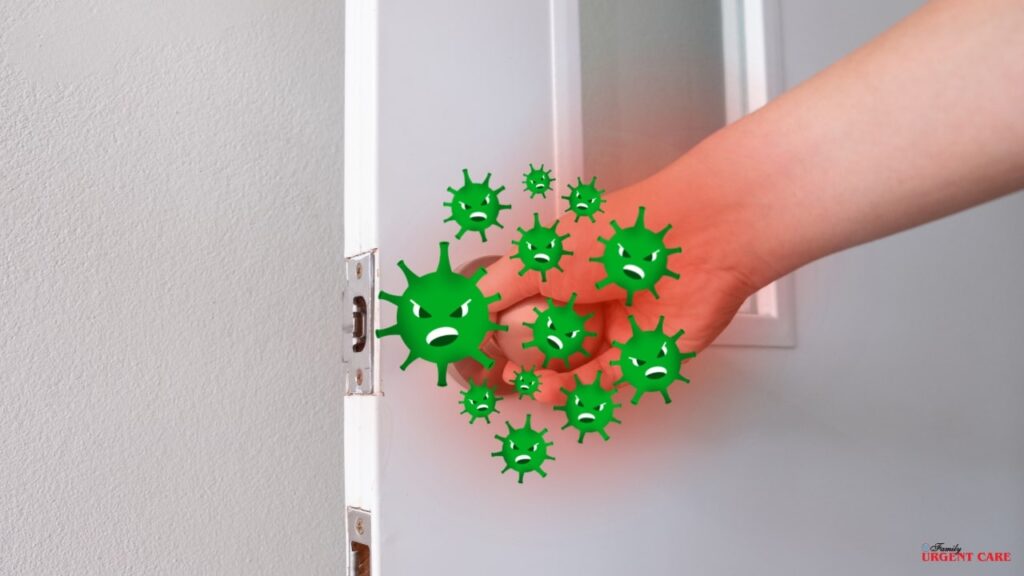When the COVID-19 pandemic began, there was a lot of confusion about how the virus spread from one person to another, leaving people unsure about the different ways it could be transmitted.
An infected person can spread the virus through their breathing, coughing, and sneezing, which release respiratory droplets into the air. You can become infected either by directly inhaling these droplets or by touching surfaces or objects that have been contaminated.
COVID-19 spreads more quickly in certain areas, especially in crowded places like concerts, airports, subways, public train stations and family gatherings.
In this blog, we will go deeper into the specifics of how long the COVID-19 virus can survive on various surfaces, like common household items.
What Happens When COVID-19 Lands On Surfaces?
As COVID-19 lands on the surface, it behaves differently according to the material and environmental conditions.
The most favorable condition for a virus is to land on a living host, produce more virus, and infect more people. The COVID-19 virus cannot survive on its own, which is why it needs a suitable surface to transmit from one place to another.
When a virus lands on non-living things like tables, chairs, and paper, the transmission rate of the virus decreases because these surfaces provide unfavorable conditions for them to replicate and grow, and they die pretty quickly.
COVID-19 primarily spreads through respiratory droplets. However, touching a contaminated surface and then touching your face, mouth, or nose can get you infected.
How Long Does COVID Last on Clothes?
Contaminated clothes are not the primary method for spreading viruses, but they can still hold onto the virus for a certain period.
The duration of how long the COVID virus stays on clothes depends on the material, ranging from a few hours to a few days.
If you have been out in crowded areas, it is recommended to wash your clothes when you get home with hot water. This can eliminate the virus faster.
How Long Does COVID Live on Surfaces in Cars?
COVID stays on the surface of a car for more than 24 hours. The car’s interior has different types of surfaces, such as leather seats, plastics, and dashboards.
Studies suggest that similar types of viruses also stay on surfaces like metal, glass, and plastic for up to 9 days.
It is better to disinfect your car’s interior and exterior to avoid any kind of virus on the surface. You can keep a bottle of hand sanitizer and disinfecting wipes in your car so you can wipe down areas where the virus can stay longer.
How Long Does Covid Last On Most Common Surfaces?
The duration that COVID lasts on a surface depends on the type of material and the surrounding environmental conditions.
Plastic
COVID-19 can last on plastic surfaces for almost 3 days. In our daily lives, we frequently use items like water bottles, toys, plastic utensils and other disposable and non-disposable plastic items.
Metal
One study reports that COVID-19 can survive on metal surfaces for approximately 24 to 48 hours. This includes items like doorknobs, stainless steel, and kitchen items.
Glass
The most common glass objects on which the virus survives are windows, mirrors, TV screens and mobile phones. And it can survive for more than 90 hours to 5 days on these glass objects.
Can I Get Infected In A Swimming Pool?
If you’re in a swimming pool or in a pond, you cannot get COVID-19 while swimming inside water. This is because the virus is airborne and only spreads via respiratory droplets.
However, since people are quite close in a crowded swimming pool or change rooms, there’s a possibility that you may be infected directly through inhaling the droplets or by touching surfaces like pool chairs, glass tiles or walls.
Therefore, it’s important to maintain physical distancing during peak COVID days and take necessary precautions.
Should You Worry About COVID-19 On Surfaces?
While it is possible to catch COVID from surfaces, the risk is very low when compared to airborne transmission.
For instance, the virus landing on a glass can survive more than 90 hours but its ability to infect people decreases with time.
This is because the virus struggles to survive in unfavorable environments, requiring moisture and warmth to remain viable and infectious.
However, the short shelf life of the virus doesn’t mean that it can’t infect people.
If you are living with other people, you share a lot of surfaces in your home with them. If one person in the house gets infected, there is a high chance that you will be affected because you are sharing the same objects, like the door and table, and by touching any of these objects, you will catch the germs.
A quick solution is to regularly clean and disinfect the surfaces around you.
Can Disinfection Kill Newer Variants Of COVID?
Yes, despite the genetic changes of the newer COVID variants like KP2 and KP1, disinfection can kill any new variants, the Environmental Protection Agency reports.
Therefore, during the peak COVID days, like the recent summer wave that hit US, you should take extra caution and disinfect all the common household items.
The most common types of disinfectants that are approved by EPA are:
- Alcohol-based solutions
- Bleach solutions
- Peracetic acid
- Hydrogen Peroxide
If you prefer any other product, you can check whether it is approved by the EPA or not as there are multiple false products available in the market.
Furthermore, if you are living with someone who has COVID-19, then don’t forget to disinfect your commonly used household items almost two times daily.
Conclusion
Overall, the risk of contracting COVID-19 by touching surfaces is minimal, but this risk increases in public places where surfaces are frequently touched by many people.
The virus stays longer on plastic and stainless surfaces as compared to cloth, paper, and cardboard. Temperature and humidity also play a role in influencing virus survival.
To help prevent the spread of viruses, it’s important to avoid close contact with others when you’re not feeling well. Taking this precautionary step reduces the risk of virus transmission.

